#inselberg rock formations
Text
Day 7

Want to know what I've been researching today? Rocks. Specifically, odd rocks that stand out from the rest of their locale. Glacial Erratics, Inselbergs, Volcanic protrusions, you get the idea.
Want to see some of the awesome bits and pieces I've found (in no particular order)?
This is a vertical map of the deepest cave system currently known:
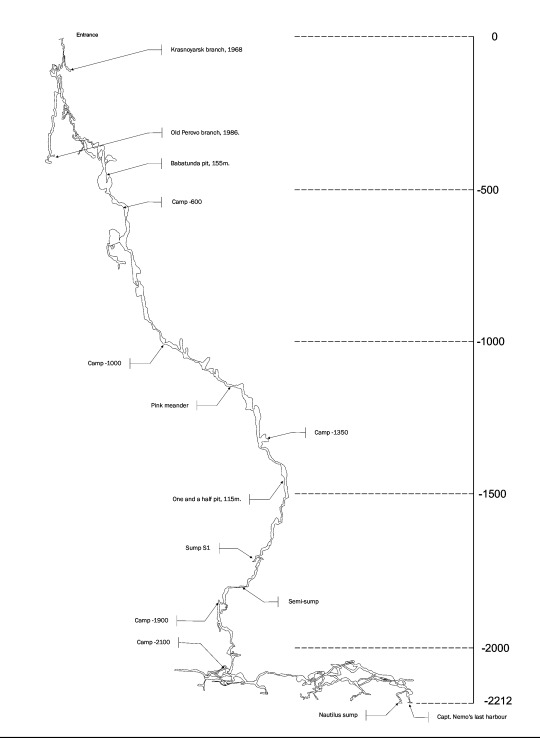
Veryovkina Cave or ვერიოვკინის მღვიმე in Georgia, at 2,212 metres deep.
Image credit and CCAS License Link
Next:

Hårteigen mountain in Norway, a good example of an Inselberg formation.
Image credit and CCAS License Link
And:

The Colossal Statue of Shapur I, second shah of the Sassanid Empire, carved from a stalagmite over 1400 years ago (exact dates are up for heavy debate). Located in southern Iran near the ruins of Bishapur.
Image credit and CCAS License Link
16 notes
·
View notes
Text
An inselberg or monadnock (/məˈnædnɒk/) is an isolated rock hill, knob, ridge, or small mountain that rises abruptly from a gently sloping or virtually level surrounding plain. In Southern Africa a similar formation of granite is known as a koppie, an Afrikaans word ("little head") from the Dutch diminutive word kopje.[1] If the inselberg is dome-shaped and formed from granite or gneiss, it can also be called a bornhardt, though not all bornhardts are inselbergs.
They really knocked it out of the park with these words
3 notes
·
View notes
Text
Easter Things to do in Egypt
Easter is the one holiday when people dance to music, eat lavish meals, and enjoy themselves till the early hours of the morning. One of those nights that have stuck in my memory for weeks. Explore some of the party spots to ring in Easter. So, what more could someone possibly want? Have the time of your life, by all means. and enjoy Easter Things to do in Egypt
Diving, snorkeling, swimming, kitesurfing, hiking, sunbathing, reading, or just lounging on the beach are a few of the most thrilling and adventurous activities one can engage in. One can observe the shooting stars by the fire on Easter Egypt Things to do to make it a little more exciting.
The Sinai Peninsula is a distinctive area separate from the rest of Egypt and is renowned for its excellent diving activities. Underwater in the Red Sea is among the most enjoyable activities to take part in during Egyptian Easter. The resort at Sharm el Sheikh and the small hamlet of Dahab are two of the best locations.
It is the perfect location for those lone travelers to spend Easter Tours in Egypt near the Red Sea. This small village, which is teeming with cafes, dive shops, and hostels, is a must-see. Giving their taste buds pleasure with hummus, taking part in adventurous activities like diving and swimming, and relaxing with yoga and sunbathing can all help tourists have the perfect vacation.
When celebrating Easter in Egypt, you're missing out if you don't take a trip to the Nile. Taking a sail up the Nile is one of Egypt's most iconic excursions. Visitors can make use of the boats, eateries, swimming pool, or the upper deck of a ship floating in the river while taking in the breathtaking views.
One option available to individuals is the immaculate Egyptian felucca. People should experience and enjoy sailing along the river while taking in the magnificent sunset. The best way to ring in Easter is to spend a few hours partying on a felucca with your loved ones.
The White Desert, located a few hours outside of Cairo, gives visitors the impression that they are on the moon's surface. The distinctive calcium rock formations are dispersed throughout like incredible abstract artwork. The majority of the rocks resemble Inselberg and Monolith, but others resemble ice cream cones and mushrooms.
The white desert, which is home to an unusual and breathtaking natural chalk-rock museum, is a must-see. The majority of Egyptians like the concept of camping out in the desert at night and watching the sunset when it comes to Easter celebrations. As the sun sets, the calcium sea shows an array of orange and fuchsia hues in the sky. What more could somebody possibly need to experience the ideal Easter in Egypt?
1- Cairo Tours in Easter
2- Cairo Tour Packages in Easter
3- Cairo and Nile Cruise Tour in Easter
4- Easter Travel Packages in Egypt
5- 10 Days Egypt Tours in Easter
For more info. kindly visit www.maestroegypttours.com
or send your request to [email protected]
Tel : +201001422529
#Egypt Easter Tours#Egypt Easter Packages#Easter in Egypt#egypt easter holidays#egyptian easter#Easter Egypt 2023#Easter Nile Cruise Tours#Cairo Tours in Easter
0 notes
Photo
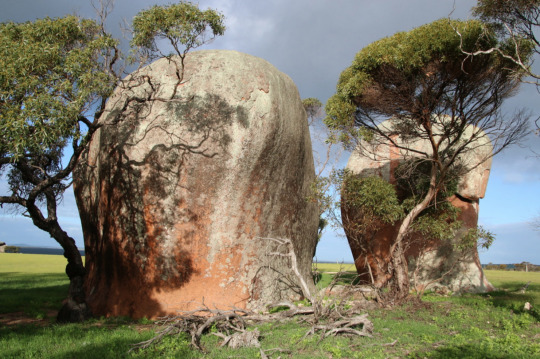
Murphy's Haystacks
#Murphy's Haystacks#rock formation#nature#inselberg rock formations#granite#quartz#south australia#australia#landscape#weird#odd#rocks#big rocks
335 notes
·
View notes
Text
*kicks this out of my drafts*
Random Notes-Inselbergs
Inselbergs are isolated elevated rock hills, mountains, knobs abruptly rising in gently sloping or even flat areas, making them look out of place. (Their names mean island mountains in german! Makes sense, doesn’t it?)

Inselbergs result when a rock formation resistent to erosion, such as granite, occuring within softer rocks gets exposed by erosion and the lowering of the surrounding landscape! Ah. The elements.
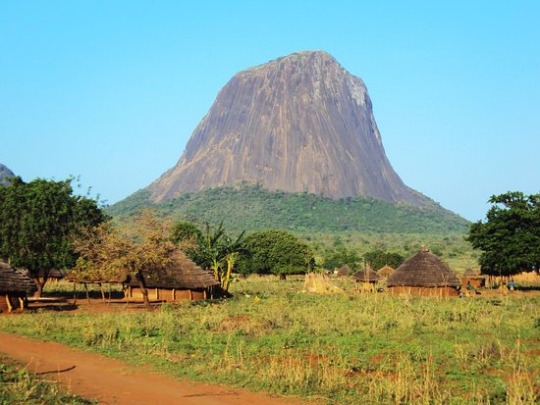
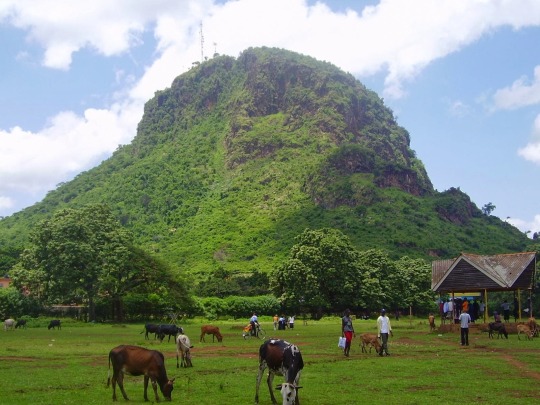
In Africa this kind of granite formation is called a koppie (“little head” in Africaans)

Hoy’s Koppie (South Africa)
3 notes
·
View notes
Photo

Movie Mars on Earth Wadi Rum looks like few other places on Earth. In fact, the distinctive desert landscapes have inspired more than a few filmmakers to use the valley in southern Jordan as a stand-in for Mars. Among them was Ridley Scott, director of the 2015 film The Martian. Scott made frequent use of Wadi Rum’s scenery, often bringing viewers along on panoramic tours of surreal inselbergs, spires, and turrets of rock as fictional astronaut Mark Watney tries to survive and make his way home from Mars. When viewed from space, it is easy to see why Scott chose this place. The colors and textures of Wadi Rum—shown in the natural-color Landsat 8 image above—are a close match to those found on Mars. The area, which appears in the movie on multiple occasions, features towering sandstone and granite inselbergs that punctuate valleys blanketed with iron-rich sand. It includes one of the region’s most iconic rock formations: the Seven Pillars of Wisdom, a group of natural stone pillars that jut from the northern edge of Jebel Um Ishrin. Many of the prominent rock formations in Wadi Rum are comprised of partially eroded layers of sedimentary rock—mostly purple and white sandstones—that formed hundreds of millions of years ago when sea levels were higher and the area was muck at the bottom of an ocean on top of a base of granite. After sea levels dropped and exposed the new sedimentary rocks, a combination of tectonic lifting, wind, and water eroded and sculpted them, leaving valleys filled with sand and jagged terrain. Scott felt the scenery was such a good approximation of Mars that he only made a few changes when editing. He added a background red dust to many shots, and occasionally added computer-generated clouds and dust storms for dramatic effect. “I didn’t do anything but shoot it at the right time, from the right positions,” Ridley told Space.com. “To me, [Wadi Rum] is the Eighth Wonder of the World. It’s incredible.” Mars aficionados and sci-fi movie buffs can keep an eye out for Wadi Rum in several other movies. Red Planet (2000), The Last Days on Mars (2013), Prometheus (2012), Rogue One: A Star Wars Story (2016), and Star Wars: The Rise of Skywalker (2019) all used Wadi Rum as a stand-in for Mars or other fictional desert planets. “I was in awe of that place, it was really, really special,” actor Matt Damon said of the time he spent filming there. “[It is] one of the most spectacular and beautiful places I have ever seen, and like nothing I’ve ever seen anywhere else on Earth.” NASA Earth Observatory image by Lauren Dauphin, using Landsat data from the U.S. Geological Survey. Story by Adam Voiland.
6 notes
·
View notes
Video
youtube
Spitzkoppe Lodge is situated on the northern periphery of the Spitzkoppe inselberg, between huge granite boulders, which were created more than 150 million years ago. Limited use of concrete with elevated floors and decks and composite materials for walls, which can be dismantled easily, will enable nature to restore itself in just a few months after deconstruction. The tented roof shapes simulate the surrounding rock formations and soften the square building plan form. Situated on the inland edge of the Namib Desert, the climate of the Spitzkoppe Conservation Area is arid, with a mean annual rainfall of 50mm and a high evaporation rate of 3200mm per annum. Most rainfall occurs between January and April, and with the granite outcrops being impermeable, rainfall runoff collects at the foot of the outcrops creating unique micro-habitats.
----------------------------------------------------------
Die Spitzkoppe Lodge befindet sich am nördlichen Rand des Spitzkoppe Inselbergs zwischen riesigen Granitblöcken, die vor mehr als 150 Millionen Jahren gebildet wurden. Die begrenzte Verwendung von Beton mit erhöhten Böden und Decks sowie Verbundwerkstoffen für Wände, die leicht abgebaut werden können, ermöglicht es der Natur, sich innerhalb weniger Monate nach dem Rückbau wieder zu erholen. Die Zeltdachformen simulieren die umgebenden Felsformationen und machen die quadratische Bauplanform weicher. Das Klima des Spitzkoppe-Schutzgebiets am Binnenrand der Namib-Wüste ist trocken, mit einem durchschnittlichen jährlichen Niederschlag von 50 mm und einer hohen Verdunstungsrate von 3200 mm pro Jahr. Die meisten Niederschläge fallen zwischen Januar und April, und da die Granitaufschlüsse undurchlässig sind, sammelt sich der Niederschlag am Fuße der Aufschlüsse, wodurch einzigartige Mikro-Lebensräume entstehen.
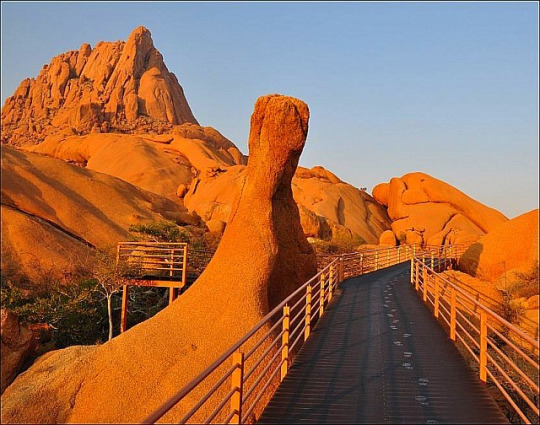






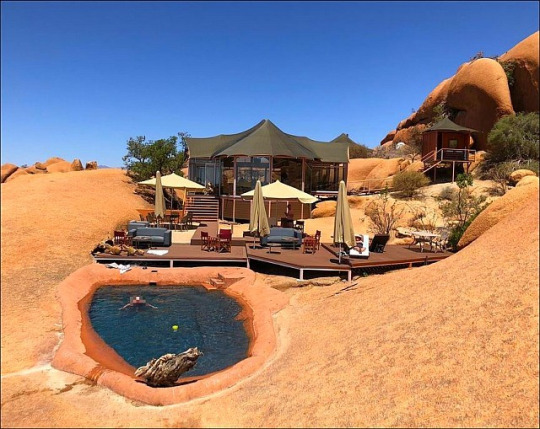


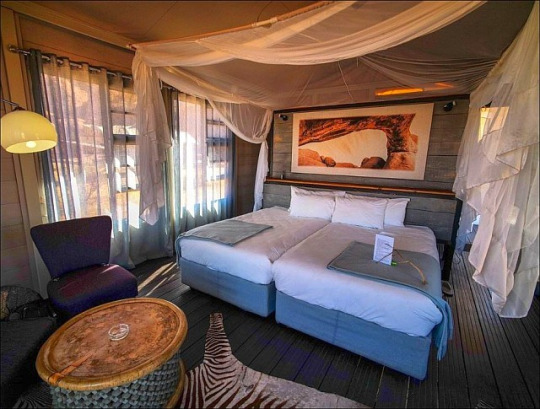
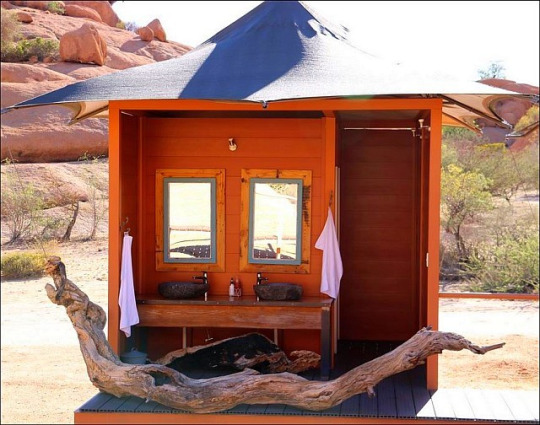
3 notes
·
View notes
Photo
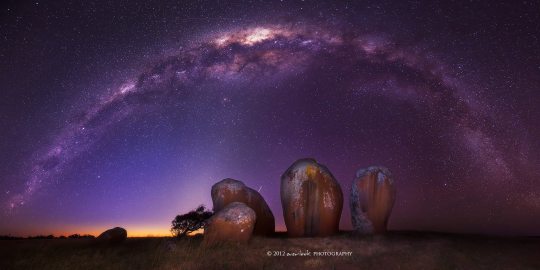
MILKY WAY OVER MURPHY'S HAYSTACKS
This image, taken by Dylan Toh, shows the Milky Way over Murphy's Haystacks, which are inselberg rock formations found between Streaky Bay and Port Kenny on the Eyre Peninsula in South Australia. The rock formations got their name when a traveller in a coach saw the formation in the distance and asked how a farmer could produce so much hay. The rocks became known as Murphy's Haystacks as the farm was on a property owned by a man named Murphy.
Toh took 13 vertical images with a 5dmk3, Canon 16-35mm F2.8 II lens, at 16mm, F3.2, iso3200, 30 second exposure with light painting on the rocks done with a flash light for 3- 4 seconds of each exposure. The photos were shot in between last light and moonrise, approximately 8pm.
-TEL
Image: Dylan Toh, Everlook photography http://www.everlookphotography.com/ https://www.facebook.com/everlookphotography
http://www.streakybay.sa.gov.au/page.aspx?u=237
#milky way#dark sky#australia#inselberg#murphy's haystacks#geology#nature#landscape#night sky#the universe#photography#the real universe
18 notes
·
View notes
Text
Honeymoon Day Three: Waterfalls, Basalt, and a Very Smelly Dog
We spent another dreamy, quiet morning in another dreamy, quiet AirBnB before heading eastward to do some sightseeing. Today was the first windy, rainy day so far, which is apparently unusual; it rains all the time here. While we’re happy to have had two very sunny days, Iceland is beautiful in all weather, so we didn’t let a little rain stop us.
Immediately east of Selfoss, the landscape honestly reminded me of a very gloomy Colorado. There was lots of wide, flat farmland leading right up to the feet high-prominence mountains. The two-lane highway has the same passing rules too, so I took the morning shift behind the wheel, as I am much more comfortable flooring it to zoom past slowpokes than John. Thanks for the road trips, Mom and Dad.
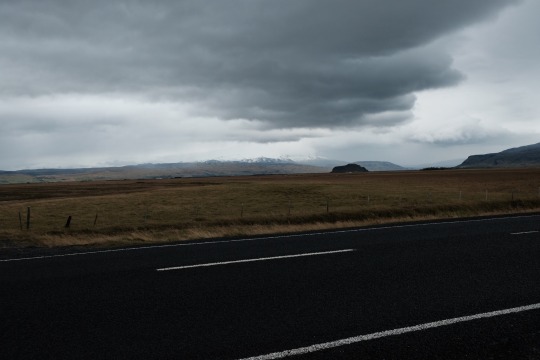
We weren’t specifically planning to see any waterfalls today, but Seljalandsfoss is visible from the highway, and I’d like to see you resist a 200-foot waterfall. The parking lot was packed and there were a lot of other people there, but the opportunity to get behind a waterfall like in Skyrim was too good to pass up. Plus, we had to put our new raincoats to the test.

We continued on through Vik after a brief stop for lunch and to fill up the tank. It was raining so hard at that point that we got wetter getting gas than we did walking behind the waterfall. After lunch, a very interesting land formation caught our eye from the road, but we weren’t sure how long the canyon hike we were aiming for would last, so we pinned it for later and continued on to Fjaðrárgljúfur Canyon. We had high hopes for it, and it did not disappoint.

This 300-foot deep canyon is unbelievable. The colors—mossy green, deep teal, and near-black charcoal—will probably stay with me forever. Look for that color palette in every home I ever get to decorate.
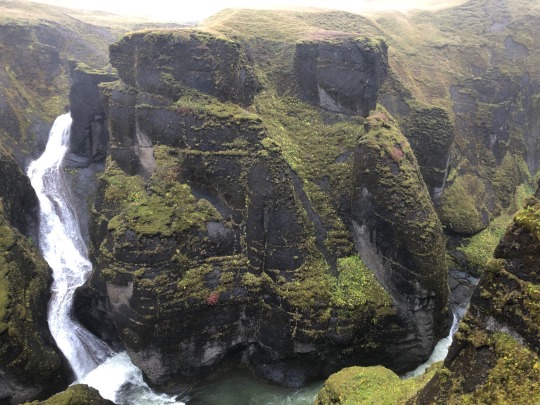
The raincoats worked, by the way.
Fjaðrárgljúfur was a tough act to follow, but we decided to check out the big ol’ rock we had skipped earlier. It turned out to be an inselberg (basically a land-island) called Hjörleifshöfði, which my friend Dave tells me could be “broken-sword” or “broken-heart” so...hell yeah. We drove around the south side of the berg and found a very cool cave nicknamed the Yoda Cave. This was one of the few scenic places we’ve been totally alone so far in Iceland, so we had a lot of fun scrambling around on rocks and hollering at elves.

Feeling ambitious and inspired by the rain letting up a little, we decided to hit one more major sightseeing location before dinner: Reynisfjara Beach, famous for its black sand, basalt columns, and thundering waves. It was...so windy. I grew up in a windy state, y’all, and this was still probably one of the top five windiest places I’ve ever been. It was absolutely worth it, though, holy wow.
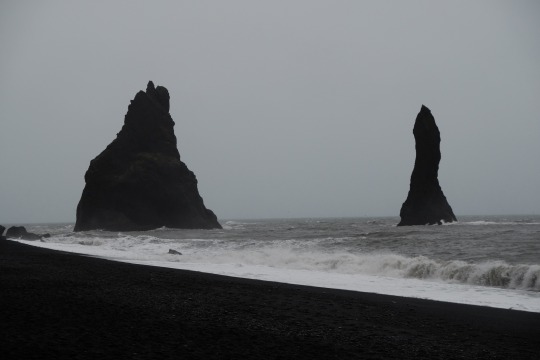
The rock formations here are really unlike anything I’ve ever seen. We were absolutely mesmerized by the sharp, geometric patterns in the cliff-face.

We loved this beach. This won’t be new information for anyone visiting the south of Iceland; it’s not like we discovered it or anything. Still, even on a day with huge gusts of wind and freezing rain, it was an absolutely gorgeous experience.
We grabbed dinner at a charming little restaurant called Gamla Fjósið that was recommended by our host tonight. John had fish and I had veggie curry. I also made friends with an adorable but very stinky Icelandic sheepdog who followed me around the parking lot; fear not for John, though, because not ten minutes later, he charmed the fat orange cat at our Airbnb.


Speaking of our lodgings for the night, I am absolutely delighted to report that on the property of this guesthouse is a BIG SPOOKY ROCK populated with LITTLE CREEPY HUTS. I explored them while John took pictures and politely requested that I not crawl on very rickety sod roofing.

Iceland is so cool, you guys.
2 notes
·
View notes
Text
25th-26th Sep. Streaky Bay & Point Labatt.
Our last stop on the peninsula before we start across the Nullabor - tomorrow. Very excited by the prospect!
En route to Streaky Bay we came across the most bizarre rock formations one can imagine - Murphy's Haystacks.
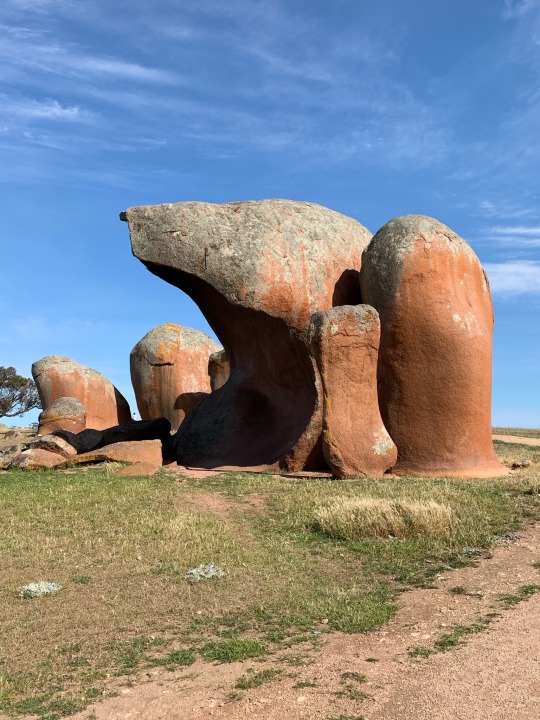
These pink granite globules acquired their name from an unnamed Scottish agricultural expert who insisted that a good hay farmer should harrow his land in order to produce the best results. I know, Murphy is an Irish name. Bear with me.

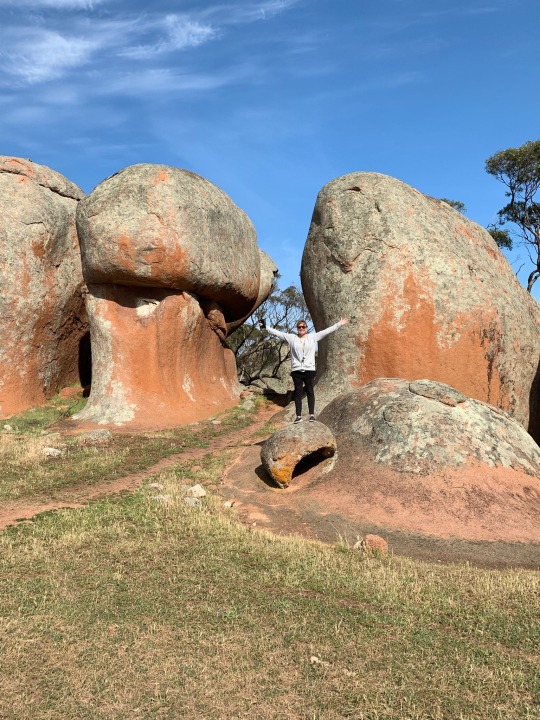
The story goes thus: our myopic Percy Thrower was travelling on a coach when he noticed these compelling rock formations in the distance. He immediately informed the driver and the other passengers that the farmer must must have harrowed his land to produce so much excellent hay and fodder. The rock formations were discovered on land belonging to one Sean Murphy...

The really interesting part is how they were formed. The rocks were not pushed to the surface by pressure or volcanic activity; it was the result of wind and rain, gradually eroding the surrounding plains that exposed them. Those same elements then set to work on the rocks themselves, sculpting and smoothing them into shapes that remind me of lava lamps.
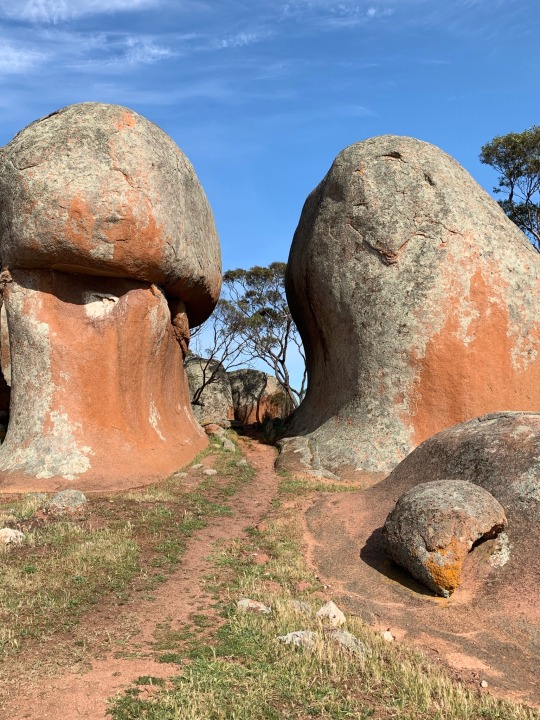
Technically, the Haystacks are called Inselbergs, from the German:
"insel" - island, "berg" - mountain.
This particular formation is 1500m years old!
And finally, Point Labatt, a breeding colony for one of the most endangered sea mammals on the planet - the Australian Sea Lion.

There are dozens of them down there but the cliffs are sooo high they are difficult to spot.

The cliffs were spectacular
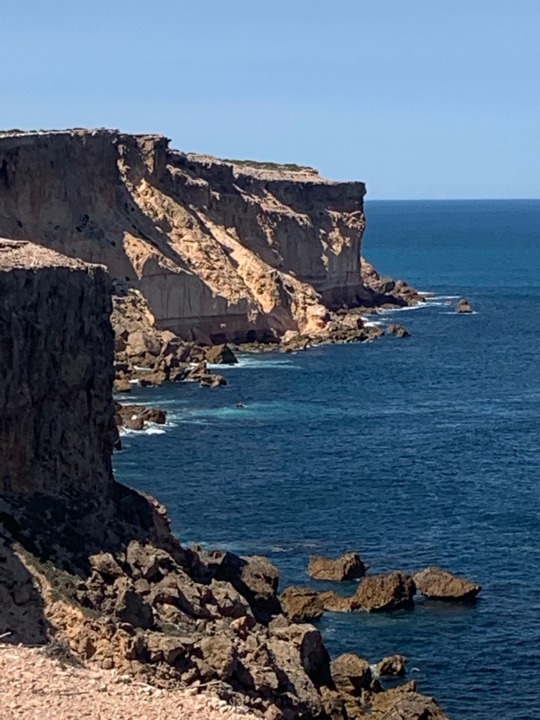
And so, goodbye to Streaky Bay. Buy one, get two free.

1 note
·
View note
Photo
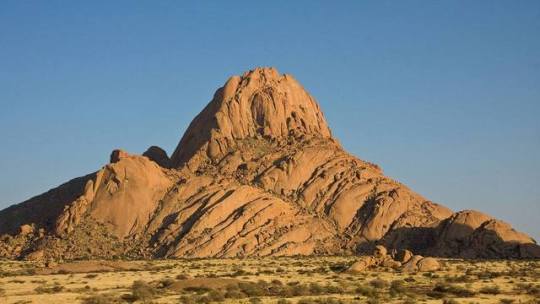
Spitzkoppe –The Matterhorn of Namibia
The Spitzkoppe area is a paradise for hikers and mountaineers and is also used as a filming location. Visitors to the Spitzkoppe can explore ancient rock paintings and fascinating rock formations.
Xandi
Image Credit: https://bit.ly/2qgw0DD Sources: https://bit.ly/2zex5Qr https://bit.ly/2qgC2Eh
80 notes
·
View notes
Text
Juniper publishers- Juniper Publishers-Inselbergs of Venezuelan Guayana Region: A Natural Laboratory for Plant Ecology Research
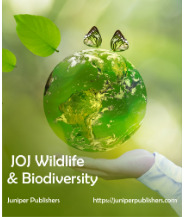
Opinion
The Guayana shield is one of the most important biogeographic regions of the world, with a complex matrix of ecosystems and different types of vegetation [1-4]. One of the most outstanding ecological units of the region are the granitic outcrops, also known as inselbergs (from the German Insel: island, and Berg: mountain), and locally as lajas. These rock formations have high plant species diversity, a high number of endemic species with restricted geographical distribution [2-3]. From a biogeographical approach, these geological formations are also considered as continental islands, mainly because of the ecological processes that depend to a large extent on geographic isolation [5]. This geographical isolation confers unique ecological conditions for the formation of different types of plant communities on a small spatial scale. However, since pioneering research on Guayana inselbergs vegetation types, e.g., [3-4], knowledge about plant community ecology is still limited as a basis for establishing conservation measures [6].
The Guayana inselbergs present different types of plant communities, which are shaped by a complex system of environmental gradients, mainly by the availability of water, topography and the depth of the substrates [5,7-8]. Thus, the mosaic of habitats present in the inselbergs of Guayana region, can occur discontinuously separated with different types of vegetation, such as epilithic (on bare rock), casmophytic (between cracks), forest in the depressions, continuous forests in flat sites of the peaks, and in accumulations of large blocks of granite. In addition, one of the most dominant types of vegetation are the patches of vegetation found in the depressions [3-5]. However, it is not yet known about the assembly rules of plant communities, especially the relative contribution of abiotic (i.e., microclimate, topography, water deficit) and biotic (i.e., facilitation) drivers, to test hypotheses in plant ecology.
The geomorphological and microenvironmental conditions of the inselbergs confer special ecological conditions where only some plant species with different types of morphological and ecophysiological adaptations can be developed [5,9-11]. This leads to a greater specialization of the species on a small spatial scale in extreme conditions compared to other surrounding ecosystems, such as savannas and forests [3-4]. For example, many of these species grow on substrates accumulated in depressions of different sizes, and on which patches of vegetation are developed [6], also known as islands of vegetation, on islands of rocky outcrops [7].
Recently some researchers have presented results on the ecology of plant communities in inselberg of Venezuelan Guayana; this has been analyzing the effect of patch size on diversity patterns [6,12]. Thus, these studies carried out in the Piedra la Tortuga Natural Monument reveal that there is a considerable number of endemic species in fine-scale vegetation patches, with up to 50% of endemic species per patch of vegetation [6]. This pattern of diversity is exclusive from a biogeographical perspective, because it is not common in other plant communities present around the inselbergs of Guayana, as for example in the savannas and forests that have a wide distribution throughout the region. This consequence has been well described, that in the inselbergs there is an important representation of endemic species (approximately 144) in relation to the entire Guayana region, and that is why it is considered as an important center of endemism in Venezuela [2-4]. On the other hand, several studies have also reported the high level of endemism existing in rocky outcrops in Australia, Africa and tropical America [5]. Although, there are still limited studies on the species-area relationship and species abundances distribution as basic information to establish new conservation areas [6].
The inselbergs of western Guayana are dominated mainly by herbaceous and shrubby growth forms (Figure 1), such as Tabebuia orinocensis, Acanthella sprucei, Commiphora leptophloes, and Pseudobomax croizatii the most representative shrub species in areas visited and studied on an ecological approach [6,12]. On the other hand, herbaceous species such as Irlbachia alata, Utricularia subulata, and Sauvagestia ramosissima, have been reported as ephemeral plants; which appear during the wetter periods when water stress is possibly less marked in these ecological formations [3-4,9-10]. In the case of shrubs, despite not being abundant in different types of plant communities in these inselbergs, they could be key species because probably generate appropriate microclimatic conditions for the establishment and survival of other species, for example in patch of vegetation found in the depression (Figure 2). Succulent stems (cactus) are other life forms characteristic of the study area, in relation to their strategies for storing water (eg Melocactus spp), also succulent leaves (Pitcairnia pruinosa, Pitcairnia armata), and geophytic as Portulaca pygmaea [4,9,13].
Go to
Final Remarks
Due to the importance value of the plant diversity present in the inselbergs of Guayana, it would be essential to continue research on the ecology of plant communities; especially due to the urgent need to create new conservation areas. For example, one of the few conservation units known in the region is the Piedra la Tortuga Natural Monument. Likewise, to establish new conservation areas with inselbergs in the Guayana region, it is necessary to consider that species with restricted distribution tend to be more vulnerable to extinction. Therefore, it is essential to know the minimum viable population of all those threatened species of inselbergs. This would allow estimating the minimum number of individuals needed to ensure a high probability of survival in the immediate future.
Finally, despite the lack of moisture as a general microclimate pattern in inselbergs, there are locally restricted habitats with vegetation that depend on seasonally humid conditions. For this reason, it is considered important to characterize the habitats within inselbergs to have enough conservation bases within these systems. For example, identify the environmental gradients where a vegetation type is developed, as well as the key species within communities. There are no doubts, that these inselbergs are an ideal scenario for the development of research in plant ecology.
To read more articles in JOJ wildlife and biodiversity
please click on: https:// juniperpublishers.com/jojwb/index.php
For more open access journals in juniper publishers
0 notes
Photo

Day 79 of #the100dayproject, exploring the #inboundlands over the course of #100daysofvagary. Though your reasonable contemporary #Birdfolk don't *really* believe this, common #superstition surrounds unusual, isolated #rock formations. A solitary #butte, #inselberg, #monadnock, #tor, #kopje, #mesa, or #seastack is said to be the tip of a giant #egg, buried partially under the earth to keep it safe and warm until such time as it is ready to hatch. (Coming across the occasional #stone run or #boulder pile is, of course, where one of these ancient #Giants would have hatched free.) . . . . . #illustration #exploration #worldbuilding #adventure #100dayproject #artist #creative #game #100days #art #mythology #bird #birds #myth (at Nashville, Tennessee)
#birds#mythology#stone#the100dayproject#creative#egg#game#giants#artist#tor#monadnock#100days#exploration#illustration#butte#seastack#kopje#superstition#adventure#100dayproject#boulder#inboundlands#rock#inselberg#birdfolk#art#bird#worldbuilding#myth#100daysofvagary
1 note
·
View note
Photo
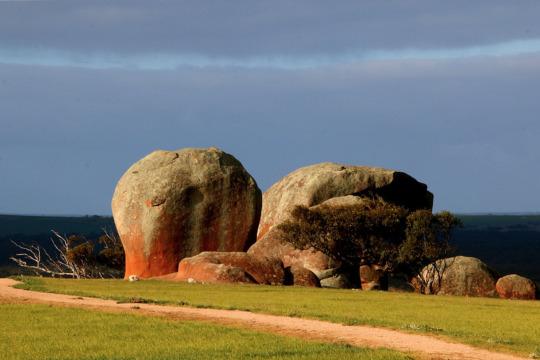
Murphy's Haystacks
#Murphy's Haystacks#rock formation#nature#inselberg rock formations#granite#quartz#south australia#australia#landscape#weird#odd#rocks#big rocks
27 notes
·
View notes
Text
Ayers Rock - a wonder of the natural world
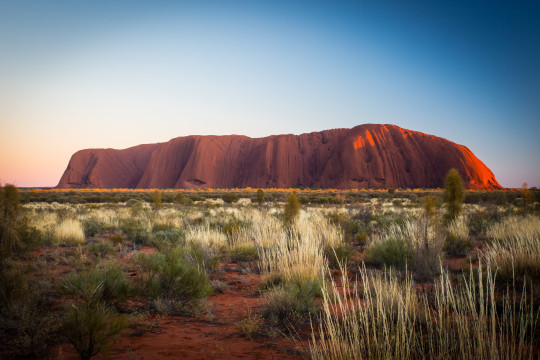
Ayers Rock, officially Uluru / Ayers Rock, is considered a wonder of the natural world. Situated in the central Australian outback, it is a rock formation (what geologists term an “inselberg” – an “island mountain”) that leaves one in awe of its size and beauty. It has adorned many a cover of books describing the wonders of Australia for decades and continues to be one of the most popular tourist sites in the country. Visitors to Uluru / Ayers Rock have a chance to climb it, or even fly in a light aircraft or hot-air balloon above it and enjoy spectacular views from the top and experience a great wildlife experience in the Central Australian outback.
Here are some of the top places to visit in Ayers Rock
Kata Tjuta
Valley of the Winds
Uluru Sunset Viewing Area
Imalung Lookout
Mulgara Gallery
Things to do in Ayers Rock
Ogle at the Rock's Sheer Size
Walk, Hike or Ride Around the Rock
Take a Camel Tour
Experience Aboriginal Culture
Go Stargazing
#travelcenteruk#travelvibes#wanderlust#traveller#travellife#travelgoals#bestplacetotravel#llairfaresmarketleader#Travelcenter#Kozhikode#AyersRock#Australia
0 notes
Text
The 6 Gourmet Guardian Buddhas of the Gourmet World...
//An brand new expansion on Earl’s 7 Chakra Beasts forms and what happened during his prison sentence in the Gourmet World.
**(During his prison sentence of 7 years in the Gourmet World, for escaping another Colombian prison due to shit really going down there, and in the periods in-between his many failed attempts at fighting the 8 Kings for the legendary foods, that are a part of Acacia's Full Course, Earl send out to boost up his Chakra Beasts forms by going to eat particular parts of 7 much-feared & renowned species of *ancient* beasts, who are called "Gourmet Guardian Buddhas"; Their powers stem from the unity of their Gourmet Cells and their awakened inner aura, giving them such high Capture Levels, but below the 8 Kings themselves. Also, they have 'Quadrupedal Stance' & 'Bipedal Stance'. All thanks to getting info on the few inhabitants that do live in the Gourmet World)
1*="Acala Giraffe" (Phantom Gourmet Guardian Buddha)=
*-It is an gigantic, eight-horned giraffe Guardian Buddha that is constantly on fire, where the spots are white fire, the rest of it are in an orange colored fire, and each tip of its very short horns are pitch-fork shaped; So does its hooves and tip of its tail.
-'Gourmet Ability' of this *Gourmet Guardian Buddha: Having the attribute of doubt to its fire, where an immense amount of spiritual force from the fire, down to even its heat, harbors out doubts of all kinds from an target's brain & soul, can regenerate/heal with the fire alone, can animate the fire to the point of fire figures being made, 'animate' even inanimate objects with just 'life-giving' fire, can emit fiery aura projections, even those the size of the entire Bagklock Earth to attempt to thumb press Earl from space, and weaponry made out of 'solid' fire, mixed of inner aura and Gourmet Cells, like an favored pitchfork.
=+Body part eaten, with (simple) ability added to an Chakra Beast:
The nose of Acala Giraffe; Having the attribute of doubt to one's own fire, which is Earl's aura fire in his case, as a secondary 'layer' of 'fur' for the Chakra Beast Ratel/Honey Badger form, where an immense amount of spiritual force from the fire, down to even its heat, harbors out doubts of all kinds from an target's brain & soul.
-+Capture Level: 5,070.
=-+Gourmet World Area: Area 8, at Nightmare Hill.
+++Height: 11.110 kilometers tall.
+=+Physical improvement to the Chakra Beast Ratel form: Pitchfork-like claws, canine teeth, & an retractable 2nd 'layer' of fiery doubt-causing-to-others 'fur'.
2*="Tathaagata Yak" (Mammal Gourmet Guardian Buddha)=
*-It is an GIANT yak Guardian Buddha that has green 'fur' made out of wind & air, in an azure color, sweats wind, and its seven horns' tips, & hooves, are shaped like grafter knife blades, while the horns curve and face forwards.
-'Gourmet Ability' of this *Gourmet Guardian Buddha: Having the attribute of daydreaming while wake to its wind, Tathaagata Yak's 5,000 mph wind/air brings livid daydreams to the brains of anyone who is hit with the wind, even with a gentle breeze version, to the point of actually seeing a daydream 'reflection' of one's very soul, which Yak can harm shockingly, ox-like strength in the force of the wind, and can make wind/air into a liquid form, while still making wind still be wind.
=+Body part eaten, with (simple) ability added to an Chakra Beast:
The pineal gland in its brain's center; Having the attribute of vivid daydreaming to its wind, the body & skin pores of the Chakra Beast wolf form can be produce for an second 'layer' of 'fur', which harbors livid daydreams to where even the 'reflection' of one's soul can be seen, possibly creating all kinds of mental chaos.
-+Capture Level: 5,070.
=-+Gourmet World Area: Area 7, at the Southern Mountain region.
+++Height: 7.210 kilometers tall.
+=+Physical improvement to the Chakra Beast Wolf form: The nails, the canine teeth, and new tusks in the shape of grafter knife blades, along with seven horns, which the tips are shaped like grafter knife blades, and an body that produces vivid daydreaming causing, down to the skin pores.
3*="Manjusrikumaarabhuuta Mer-Wolverine/Majusri Mer-Wolverine" (Aqua-Mammal Gourmet Guardian Buddha)=
*-An TITAN of an dark blue mer-wolverine, that is bald, with moon crater-like wounds on its body, that pushes out flows of light gray GRAVITY, has six canine teeth, three in the top, three at the bottom, in the shape of garden hoe/hork blades, as it also goes to its claws.
-'Gourmet Ability' of this *Gourmet Guardian Buddha: With the attribute of warping form, the gravity of Wolverine can be manipulated to a point of a piece of gravity itself becoming either solid, liquid, gas even, & fire plasma, even in underwater, while the target's literal form, their 'outline' & the such, becomes warped by even the mere field of the gravity pieces, or blasts.
=+Body part eaten, with (simple) ability added to an Chakra Beast:
The Pituitary gland in the center of the brain; With the attribute of warping form, the Chakra Beast Triceratops releases a field of powerful, 5G gravity that warps the form of the target's soul for 8 seconds, if hit, or just 3 seconds by the field or shockwave, if Earl misses his target.
-+Capture Level: 5,070.
=-+Gourmet World Area: Area 6, in East Six.
+++Height: 6.310 kilometers tall.
+=+Physical improvement to the Chakra Beast Triceratops form: The nails, the tips of the three horns, shaped like garden hoe/hork blades, and the frill gets 10 small hoe-shaped blades.
4*="Samantabhadra Sheep" (Mountain-made Mammal Gourmet Guardian Buddha)=
*-Simply an gigantic black sheep, with 'wool'/'shell' made out of an WHOLE mountain, with nearly straight horns that have one-sided axe shaped tips.
-'Gourmet Ability' of this *Gourmet Guardian Buddha: With the attribute of Absolute Happiness, Samantabhadra Sheep can emit an Gourmet Energy wave from its cells, create an space, like Sky Deer's Absolute Confusion Zone, and have it to where the trapped target's pain nerves are emitting pleasure instead, similar to Toki, from Hokuto no Ken. Also, they can manipulate and *generate* rock formations like whole mountains, inselbergs, hills, mudslides, rocks, stones, and shift the landscape itself.
=+Body part eaten, with (simple) ability added to an Chakra Beast:
The thyroid gland inside the neck, & ; With the attribute of Absolute Happiness, from the Chakra Beast Scorpion form's eyes, the ‘third eye’ on his brain’s front, and heart, Earl can make an Back Channel space that puts his opponent/s around an area diameter of 48 feet (14.5 meters) into an mental state of happiness & pleasure beyond belief, where the person feels so happy that it feels to them, but not physically at all, that they have twisted their body, as their nerves keeping shooting pleasure, not pain, shockingly one thousand times for every second that passes. But, this is for only for 1.5 seconds.
-+Capture Level: 5,170.
=-+Gourmet World Area: Area 5, at Multi-Gravity Valley.
+++Height: 30 kilometers tall.
+=+Physical improvement to the Chakra Beast Scorpion: An one-side axe head underneath the stinger on the Chakra Beast scorpion's tail and retractable axe blades on the forearms.
5*="Ksitigarbha-Maitreya-Bhaisajyaguru, or K.M.B. Skyopus" (Sky Tentacles Gourmet Guardian Buddha)=
*-An yellow/purple/red Tetradeca-Skyopus (14 armed octopus); The shockingly LARGEST out of the 6 Gourmet Guardian Buddha beasts, with clouds, sky rocks, and thunderous lightning coming out of its body, that has rooster-like feather wings at the sides of its head and on top, two curving upward horns on the sides of its head, made out of the same material as its 14 tentacles, the end of one of its tentacles is shaped like an tiger's head, the end of another one of its tentacles is shaped like an marmot, the ends of the rest of its tentacles are shaped like human hands, that made out of 4 hands fused together; 40 fingers each, with 4 thumbs, 2 at the sides, one at the bottom of the palm, the other in the middle of all of these fingers, has human eyes, nose, brow, yet no bones or mouth. The tiger head shaped tentacle tip has 'teeth' in the shape of one half of garden snears, the marmot's 'teeth' are in the shape of billhooks, 3 finger tips of 3 hand shaped tentacle tips are shaped like trowels, 3 more hand tentacle tip's finger tips are shaped like hand plows, 2nd to last set of tentacle hands' finger tips are shaped like pick axes, and the last bunch of tentacle hands' finger tips are shaped like scythes.
-'Gourmet Ability' of this *Gourmet Guardian Buddha: Having the four attributes of fusion, multiplying, dividing, & levitating, K.M.B. Skyopus can divide, multiply, & fuse clouds, earth, & lightning with other objects/living matter with its tentacles & Gourmet Energy from its Gourmet Cells, while also able to make them levitate. It can multiplying the physical age on an target extremely quickly, with heated air, since it is a Gourmet beast, based on how many bad deeds one has done in their lifetime, divide on the *spiritual* level to where the soul is almost split apart with an poison, the pieces sticking together while in some distance from each other in the astro plane of existence, based on how many pain one has suffered through, fusion on the Gourmet Cells, preventing cell division for a while, with simply dust from crushed rocks, & stones, based on how many teachings one should have taught to others, from simple to full speeches & helpful actions that could have been done, and levitate someone based on how many good deeds they have done in their lifetime, with Gourmet Energy-charged inner aura basically.
=+Body part eaten, with (simple) ability added to an Chakra Beast:
The pancreas gland at the back of the abdomen internally & adrenal glands above the kidneys; Really potent aura within the 7 chakras, opening up their 'streams', Gourmet Cell, & other cells within the body balance.
-+Capture Level: 5,463.
=-+Gourmet World Area: Area 4, Area 3, & Area 2, in an tetradecagonal orbit pattern.
+++Length: 41.6 miles tall/67 kilometers tall.
+++Length from tentacle tip to tentacle tip: 4320 miles/6952 kilometers long.
+=+Physical improvement to the Chakra Beast Owl & Gorilla: Scythe shaped talons & trowel blade shaped wing tips (Owl) ;&; Billhook tip shaped finger tips, & toe tips, pickaxe shaped canine teeth (Gorilla)
& 6*="Guanshiyin Lemur" (Mythical Mammal Gourmet Guardian Buddha)=
*-The shockingly smallest out of the 6 Gourmet Guardian Buddha beasts, that has just one horn on its forehead, in the shape of an dibber, finger & toe tips in that same kind of shape, and its black stripes & rings on its body and tail are invisible, muscle deep, with visible bones; While having the rest of its body, grey in color, clearly visible.
-'Gourmet Ability' of this *Gourmet Guardian Buddha: With the attribute to *true* invisibility, it can bring out millions upon millions of beams of barely invisible light, that is like water, that coats an HUGE area and makes everything invisible to one's eyes, ears, touch, taste, & smell, even to those who have eaten Acacia's Full Course & has Gourmet Energy within their Gourmet Cells. That is when it opens its eyes though. When its eyes closed, all of its attacks are those of an invisible, water-like force, even the light beam attack from its closed eyelids, glint, ears, finger tips, toe tips, chest center, tip of its tail, knees, elbows, crotch, ass, mouth, armpits, nipples, nose, eyebrows, forehead center, and scalp. Only those with all of their aura nodes open, externally & internally, can sense the invisible attacks & the one phase of Guanshiyin Lemur where it opens its eyes. Not even the Eight Kings have their aura nodes open. It even has an third 'stance' where it shrinks down to only 4 feet, 2 inches tall.
=+Body part eaten, with (simple) ability added to an Chakra Beast:
The rock oven cooked testicles & entire brain; Through one's own aura nodes awakened, inside only though, Earl's Chakra Beast Lion form can sense invisible presences & other things and that their other senses can't sense.
-+Capture Level: 5,999.
=-+Gourmet World Area: Area 1.
+++Height: 300 meters tall (Godzilla Earth)/4'2" tall at its third 'stance'.
+=+Physical improvement to the Chakra Beast: Lion: Teeth, claws, and an single horn on the forehead are shaped like dibbers.
(These 6 Gourmet Guardian Buddha species are said to be those who took a different path than the species that the 8 Kings are a part of. If they weren't around, these 6 Guardian Buddhas would have been the 6 Kings of the Gourmet World, with Skyopus being the 'Three Area King'. Despite that, these Buddha species, numbering over 20 thousand, with several top tier members within their species, like the ones Earl fought for a part of their bodies to eat, do keep the 8 Kings within their Areas so they would not go to the part of the world where the IGO are at [Where the Toriko Human World is located].)
~The Bat~
#blue-scorpion-king#ooc#ooc post#Bagklock Universe#Earl Zolubu#gourmet world#toriko#Gourmet Guardian Buddhas#the bat speaks#OC#new lore
0 notes